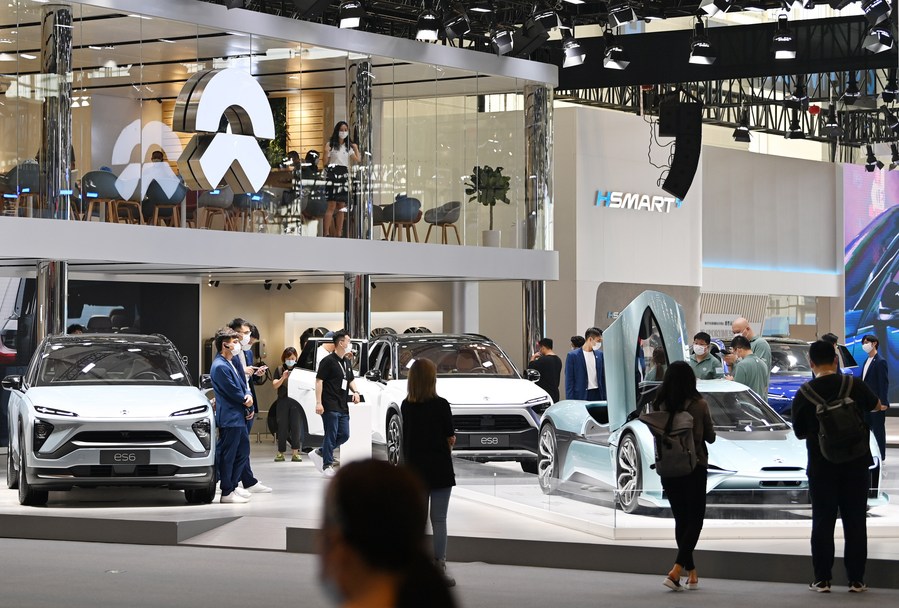China's exports of NEVs to gain growing momentum this year

Visitors view cars from Chinese electric automaker Nio during China (Tianjin) Auto Show 2021 in north China's Tianjin, Sept. 29, 2021. (Xinhua/Li Ran)
At the beginning of 2023, China's exports of new energy vehicles (NEVs) showed strong momentum, with a year-on-year increase of 48.2 percent in January.
Industry insiders pointed out that the country's exports of NEVs will further pick up steam this year buoyed by resilient industrial and supply chains and supportive policies.
-- Technological innovation
In the factory of Lynk & Co located in Yuyao, east China's Zhejiang Province, the machinery of the highly automated production line is humming with few workers.
Wang Jianyong, senior manager of the factory's pressing and stamping shop, said that at present, two press lines with five processes had been fully automated, and a stamping part can be made in as fast as two seconds.
As China's domestic automobile industry has ushered in a trend of electrification and intelligence in recent years, NEV exports have become a new driver of foreign-trade growth.
According to the China Association of Automobile Manufacturers (CAAM), the Chinese export volume of NEVs reached 679,000 units in 2022, an increase of 1.2 times year on year.
Yang Yiqing, a professor at a research institute of Zhejiang Gongshang University, said that Chinese auto companies have continued to invest in key auto parts such as design, manufacturing, research and development, which to some extent boosted the confidence of self-owned brand NEVs to vie for bigger shares of the global auto market.
According to Yang, the development of new energy passenger cars has gradually become an essential breakthrough for China to upgrade from a big car-manufacturing country to a strong one.
-- Supportive policies
Chinese NEV brands witnessed continuous expansion of footprints in overseas markets, relying not only on technological innovation, but also on the support of policies and resilient supply chains.
China's Ministry of Commerce (MOC) previously announced that it would continue to work with relevant departments to support NEV enterprises in accelerating the building of overseas marketing and after-sales service networks to increase brand publicity.
The MOC would encourage overseas institutions of competitive Chinese-financed banks to provide overseas consumption financial products and study to expand export transportation channels to transport NEVs through China-Europe freight trains.
Besides, many local governments have also introduced a string of measures to spur the development of the NEV industry.
For example, the Shenzhen Central Sub-branch of the People's Bank of China (PBOC), together with the Shenzhen Office of China Banking and Insurance Regulatory Commission and other three departments, recently issued the opinions on strengthening the financial support for the high-quality development of the NEV industrial chain, which proposed to optimize cross-border financial services to support NEV enterprises' going global.
In addition, Guangxi put forward the plan for further deepening the reform and opening up of China (Guangxi) Pilot Free Trade Zone recently, aiming to accelerate the development of ASEAN-oriented cross-border industrial and supply chains and promote the construction of NEV industry cluster.
Strong export demand also tests the capacity of the logistics supply chain. In 2022, data from China Association of the National Shipbuilding Industry showed that 69 Chinese automobile carriers were transacted, with a year-on-year increase of 90 percent, and new orders accounted for 88.7 percent of the global total.
It is reported that the export of NEVs is mainly by shipping, but the cost and threshold of railway transportation are further reduced.
Multiple Chinese places, such as Chongqing, Guangdong and Henan, have successfully opened China-Europe freight trains for NEVs. "Green channels" were set up for automobile exports to shorten customs clearance time and smooth the international logistics and supply chains.
-- Global expansion
China sees the resilient supply chain of its NEV industry, growing overseas market recognition and improved service network, said Cui Dongshu, secretary-general of the China Passenger Car Association, adding that all of these will greatly release the potential of the country's NEV exports.
Zhang Yongwei, vice-president of China Electric Vehicle Association, predicts that China's exports of NEVs will gain steam in the fast lane of expansion this year with its total export volume expected to approach 800,000 units.
Many automakers and supply chain enterprises are accelerating their entry into overseas markets.
According to the person in charge of GAC Group, the year 2023 provides significant opportunities for the export of NEVs. GAC AION will launch a global strategy to quicken the pace of auto exports and strive to exceed 1 million units worldwide in 2025 and 1.5 million units in 2030, becoming a world-class brand of high-end intelligent electric vehicles.
Zhang Yiqin, director of the brand and public relations of SAIC-GM-Wuling Automobile Co., Ltd., said that in the future, the company would improve the strategic globalization layout of NEV with targeted position, expand overseas markets and help the ecological development of NEVs in overseas markets.
It is worth noting that there are both benefits and risks in overseas markets.
According to Cui, the stability issue in the overseas trade market environment remains the most concerning, especially the impact of relations between countries.
Cui reminded that attention should be paid to whether the quality of the products meets the different needs of overseas markets.
It is recommended that domestic brands should increase research on overseas markets and make targeted adjustments to their products. Chinese brands should gradually consolidate their position in the international market to establish a better global market environment.


